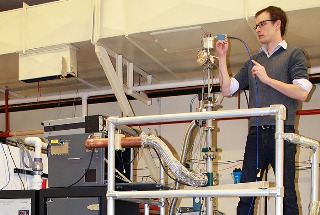Mar 27 2015
Scientists at Los Alamos National Laboratory are utilizing very high magnetic fields to understand the properties of high-temperature superconductivity. They aim to create a superconductor that would be able to function at room temperature, without the necessity of any cooling.
 Los Alamos National Laboratory scientist Brad Ramshaw conducts an experiment at the Pulsed Field Facility of the National High Magnetic Field Lab, exposing high-temperature superconductors to very high magnetic fields, changing the temperature at which the materials become perfectly conducting and revealing unique properties of these substances.
Los Alamos National Laboratory scientist Brad Ramshaw conducts an experiment at the Pulsed Field Facility of the National High Magnetic Field Lab, exposing high-temperature superconductors to very high magnetic fields, changing the temperature at which the materials become perfectly conducting and revealing unique properties of these substances.
The researchers are subjecting high-temperature superconductors to extremely high magnetic fields, altering the temperature at which the material could become a perfect conductor. This could reveal the unique properties possessed by these substances.
“High magnetic-field measurements of doped copper-oxide superconductors are paving the way to a new theory of superconductivity,” said Brad Ramshaw, a Los Alamos scientist and lead researcher on the project.
The National High Magnetic Field Laboratory (NHMFL) Pulsed Field Facility, based in Los Alamos, has record high magnetic fields. In normal materials, flow of electrical current is affected by resistance. Ramshaw and his coworkers used the NHMFL facility to conduct experiments which push the boundaries of how matter could be made to conduct electricity without being affected by resistance.
A superconductor that would function at room temperature, without any cooling requirement, is desirable. Currently, devices that use superconductors have to be cooled to far below zero. This increases the cost of the device and also adds to the complexity of the of the project, as helium or liquid nitrogen is required for cooling.
“This is a truly landmark experiment that illuminates a problem of central importance to condensed matter physics,” said MagLab Director Gregory Boebinger, who is also chief scientist for Condensed Matter Science at the National High Magnetic Field Laboratory’s headquarters in Florida. “The success of this quintessential MagLab work relied on having the best samples, the highest magnetic fields, the most sensitive techniques, and the inspired creativity of a multi-institutional research team.”
Plenty of research has been conducted on high-temperature superconductors for the past 30 years. This is because, in addition to being able to conduct electricity without any losses, they pose a fascinating and difficult “correlated-electron” physics problem.
In 1957, Bardeen, Cooper, and Schrieffer had constructed the low-temperature superconductors theory (BCS theory), for which they won the Nobel prize. The BCS theory is amongst the most notable achievements of 20th century physics. In the realm of particle physics, it forms the basis for the Higgs mechanism.
The BCS theory cannot, however, explain high-temperature superconductors such as yttrium barium copper oxide (YBa2Cu3O6+x). Hence, a new theory is required for these materials. In high-temperature superconductors, such as YBa2Cu3O6+x, their superconducting transition temperature, or the temperature at which the material becomes a perfect conductor (Tc), can be changed by 'doping', or modifying the number of electrons that take part in superconductivity.
The research team that was conducting the study on the 100-T magnet discovered that when optimal doping was achieved for YBa2Cu3O6+x, the electrons moved in a correlated manner and become very heavy.
“This tells us that the electrons are interacting very strongly when the material is an optimal superconductor,” said Ramshaw. “This is a vital piece of information for building the next theory of superconductivity.”
“An outstanding problem in the field of high-transition-temperature (high-Tc) superconductivity has been the issue as to whether a quantum critical point—a special doping value where quantum fluctuations lead to strong electron-electron interactions—is driving the remarkably high Tc 's in these materials,” he said.
Proof of superconductivity in copper oxide materials had not been found because the superconductivity was very robust. Ramshaw stated that if a quantum critical point could be shown to exist, then it would be notable progress towards dispelling the superconducting pairing mechanism.
“Assembling the pieces of this complex superconductivity puzzle is a daunting task that has involved scientists from around the world for decades,” said Charles H. Mielke, NHMFL-Pulsed Field Facility director at Los Alamos. “Though the puzzle is unfinished, this essential piece links unquestionable experimental results to fundamental condensed matter physics -- a connection made possible by an exceptional team, strong partner support and unsurpassed capabilities.”
In very strong magnetic fields that exceeded 90 T, magnetic quantum oscillations were measured as a function of hole doping.
The possibility of accessing normal metallic state by suppressing superconductivity has been realized by the strong world-record magnetic fields available at the NHMFL site. When the magnetic fields approach 100 T, quantum oscillations can be measured that are very near the maximum in Tc ~ 94 K transition temperature. These quantum oscillations provide an idea about how electrons interact with each other before they become superconducting.
The researchers accessed a wide range of dopings, and showed that at optimal doping, there existed a strong enhancement of the effective mass. The signature of a quantum critical point, and the signature of increasing electron interaction strength, is the strong enhancement of the effective mass. This point that is responsible for the broken symmetry has not yet been determined. However, Ramshaw states that it was possible that a connection existed with the charge order.
The National Science Foundation Division of Materials Research, the US Department of Energy’s Office of Science, the State of Florida, Florida State University, and the Los Alamos National Laboratory have provided funding for this project.
The research team has published their findings as a paper in the journal Science.